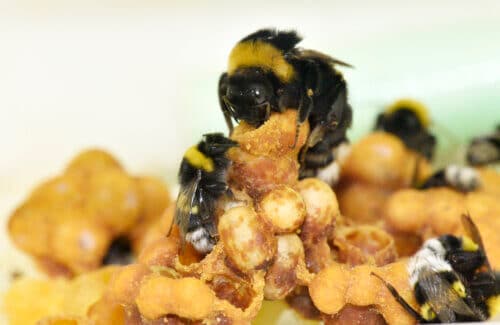This is according to a new study from the Hebrew University that examined how queens of ants and honey bees manage to have such high fertility and yet live for many years, while in most animals as well as in other bees the phenomenon of "weighting permutations" occurs, i.e. an increase in reproduction that leads to a shortening of life span

Reproduction and especially the development of ovaries and pregnancy in females requires the investment of a lot of energy and resources. In most insect species the juvenile hormone (JH) is a central hormone involved in reproductive control, but not in social insects such as the honey bee. In a recent study led by Dr. Hagai Spiegler from Prof. Guy Bloch's bee research laboratory at the Institute of Life Sciences at the Hebrew University, and published last month in the journal Hormones and Behavior, the research team attempted to answer two key questions: Why does the juvenile hormone have different roles in highly social insects Compared to individual species or species with a relatively simple society, how do queens of ants and honey bees manage to have such high fertility and yet live for many years, while in most animals as well as in other bees the phenomenon of "weighting of permutations" occurs, i.e. an increase in reproduction that leads to a shorter in life expectancy?
The study found that in bumblebees where the youth hormone regulates the development of the ovaries, the brain pays a price that is manifested in the inhibition of protein production in the brain. Bumble bees are an annual species of bee, with a single and limited reproductive cycle during their lifetime. In such a situation, there may be an evolutionary advantage in investing most of the resources in order to obtain the highest number of offspring in the same reproductive cycle, without the need to reserve many resources for the future. This strategy is not suitable for insects with perennial societies such as honey bees and other social species, in which the queen lives for many years and lays hundreds and even thousands of eggs every day.
In order to understand how the youth hormone worked, the researchers examined gene expression in the brain and fat body (which performs processes similar to the one performed by the liver in mammals) of the bumble bees to which the researchers changed the level of the hormone. "Bumblebees are a great model for examining questions about the evolution of sociality, since they are close to honeybees, but show a less complex level of sociality," Prof. Guy Bloch explains. In order to reduce the amount of youth hormone in bees, the researchers performed a tiny operation to remove the corpora allata glands, which are the only source of youth hormone in insects. To some of the bees that were operated on, the researchers added a synthetic youth hormone, thereby artificially raising the concentration of the hormone to its normal level. The researchers used RNA sequencing (RNAseq) technology to identify and quantify the gene products controlled by the youth hormone in both tissues.
Examining the genes and molecular pathways in the fat body indicated an accelerated activity of this tissue when the hormone level is high. In contrast, they found that in the brains of bees with high levels of the youth hormone, a decrease in the expression of genes related to the construction of proteins was evident. Almost all the dozens of genes that make up the cellular ribosomes (the central factory for building proteins in the cell) showed a significant decrease in the level of expression in bees in the presence of a high level of the hormone. Moreover, the researchers noticed a significant increase in the expression level of the lysosome genes - an organelle in the cell involved in the recycling of organelles and molecules for the purpose of supplying building materials to other tissues in the body. Such a decrease in the production of proteins and fats while increasing the activity of the lysosome characterizes situations of hunger, stress, or aging.
Accordingly, the researchers believed that the youth hormone at high levels causes a general mobilization of the body's resources for the benefit of accelerated development of the reproductive system. This condition causes a shortage or reduced consumption in other organs, including the brain. "Does this have consequences for the bumblebees' behavior, their memory, their cognitive abilities or their longevity? This question is still waiting for an answer", notes Dr. Spiegler.
Similar effects of the youth hormone on brain activity were not found among honey bees, where the hormone does not control the development of the ovaries. Accordingly, the researchers suggest that a change in the way the youth hormone controls the activity of various tissues was necessary in order to allow the evolution of the developed sociality of the honey bee and other species. These changes allowed increased activation of the reproductive systems without charging a fee from the brain, thus enabling high fertility for many years.
More of the topic in Hayadan:

One response
This question still awaits an answer, said Dr. Spiegler,
But the title does not wait for an answer.
People smell feminism like ants smell sugar, but with the common sense to know it's not good for us.